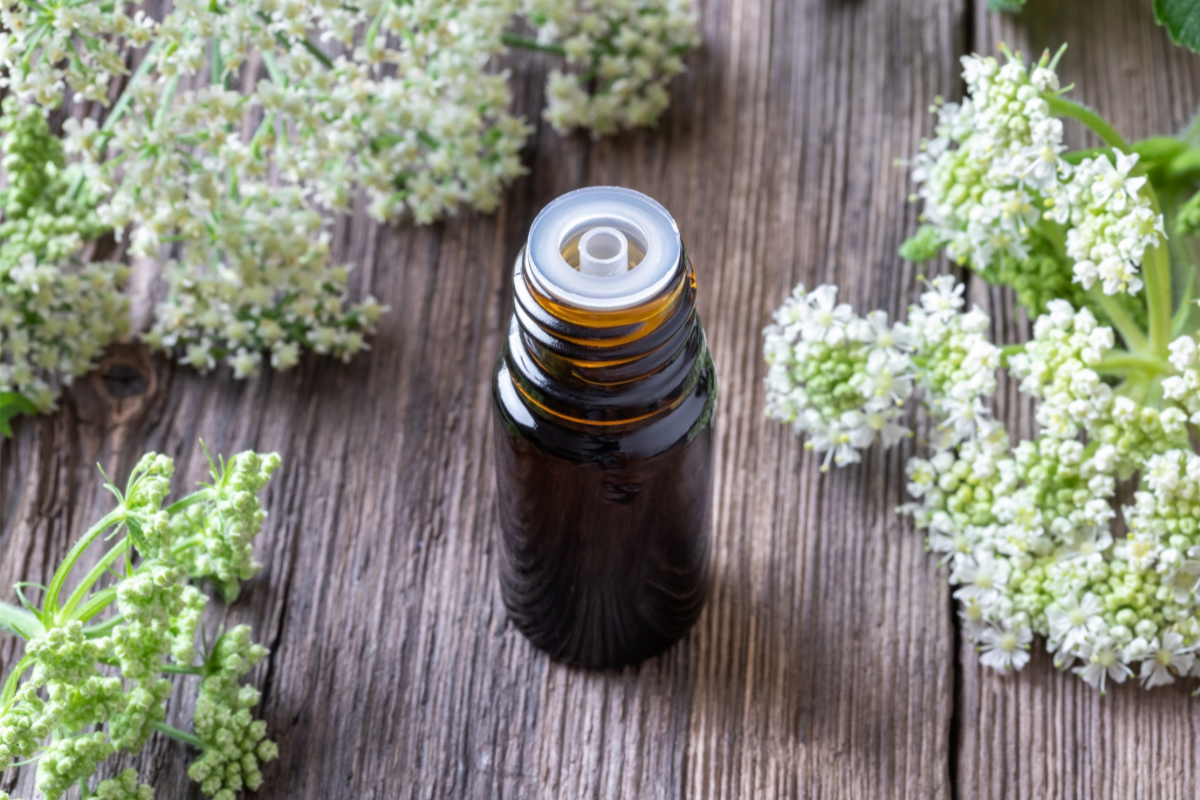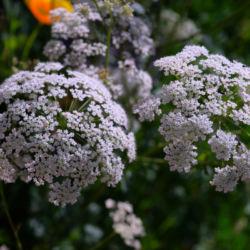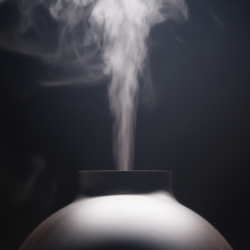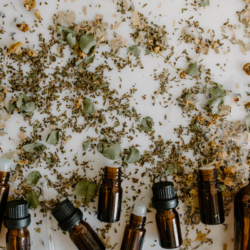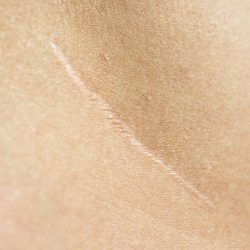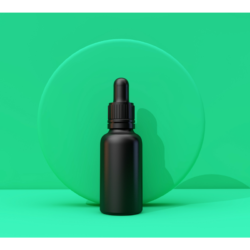Discover the secrets of angelica, a historic medicinal plant with multiple virtues. In this article, we explore the fascinating history of angelica, which has been used for centuries for its beneficial properties in natural medicine. From combating the plague in the Middle Ages to its contemporary applications in phytotherapy, angelica continues to seduce with its rich heritage and health benefits. Join us on a journey through time and science, where tradition and modern research meet to reveal the full potential of this timeless oil.
What is the history of angelica?
For centuries, apothecaries and sorcerers have used this ‘herb’. The plant’s name comes from the fact that it flowers on Saint Michael the Archangel‘s day. Angelica has many applications in traditional medicine, notably as a diuretic, sudorific and emmenagogue.Angelica, also known as ” angel weed “, owes its name to its alleged magical properties and the sweet, musky aromatic scent it gives off. This giant umbelliferous plant was said to ward off spells, and sorcerers could not resist its sweet smell. When hung around children’s necks, it was said to protect them from evil spells of all kinds. But it could also be used as an amulet by adults.
How was it used in ancient times?
It is said to have been mentioned by Pliny the Younger, to have appeared on coins from ancient Libya and to have been cultivated in ancient Egypt 3000 years before our era. Some Latinists distinguish several varieties. The name of one is more likely to evoke the ferrule used to whip slaves, while the other is a remedy.
Angelica in the Middle Ages: Authentic remedy or medical superstition?
The vernacular names for angelica vary. Names such as “Root of the Holy Spirit“, “angel herb” and “fairy herb” are the most common. According to tradition, the archangel Raphael, whose name means “God heals”, was responsible for revealing the healing properties of this plant. During the Middle Ages, angelica was frequently used to treat a variety of ailments, including the plague. It was also thought to have protective properties against supernatural forces, such as demons and bewitchments. It was also noted for its effectiveness in repelling specific dangers, such as rabid dogs.
Legend has it that theArchangel Raphael brought angelica root to Charlemagne, Emperor of the West, to save his army from the plague.
What remains certain is its presence in the Far North! Did the Vikings introduce it after the establishment of the Russian Empire? Did they have it in the first place or did they find it on their way to Russia? Hence its other name “Bohemian Herb”. One thing is certain, angelica can be found in monastery gardens across Europe in the year 1000.
Hildegarde de Bingen praised the power of angelica. It has countless medicinal properties. It has tonic, depurative and vulnerary properties, stimulates the digestive system, and helps concentration and relaxation before exams.
Angelica and the Plague in the Renaissance: Divine Remedy or Mere Illusion?
Angelica was first cultivated in Scandinavia, where it flourished in the 12th century. Its culinary use appeared in the 18th century in the form of confectionery( candiedangelica ) and liqueur. It was later used in candied form on the galette des rois. Angelica has been grown in Scandinavia since the 12th century, and in Central Europe since the 14th century (particularly in monasteries).
In the Middle Ages, the plant was reputed to ward off evil spirits. In 1602, during the plague epidemic in Niort, it became the focus of attention. To ward off contagion, people chewed the leaves and tied necklaces of seeds around their necks. Of course, there are doubts about the effectiveness of this method. That said, angelica is a powerful flea repellent.
Renaissance physicians called it the “root of the Holy Spirit”, because of its “great and diverse properties against very serious diseases”. Paracelsus (1490-1541) recounted that, during the major plague epidemics of 1510, this plant saved many of the inhabitants of Milan thanks to his recommendation to dissolve angelica powder in wine. According to Olivier de Serres (1539-1619), the precious plant “serves to keep people happy “.
Similarly, Cazin reports the case of Annibal Camoux, who died in 1759 at the age of 121 years and 3 months. He continually chewed angelica root
Published in 1716, a long-selling botanical and pharmaceutical dictionary describes angelica as “stomatal, cordial, cephalic, aperitive, sudorific, vulnerary. It resists venom. It is used to treat the plague, malignant fevers and the bite of rabid dogs, to which it is applied as a poultice. A dragme of it is swallowed against the plague, which drives out the venom through sweat” Angelica grows wild in northern regions and central Europe. Today, the cultivation of angelica for confectionery and the production of liqueurs is limited mainly to Niort and the Limagne plain north of Clermont-Ferrand.
What about today?
It is said to have many virtues. The different parts of the plant have various medicinal properties that have been recognised for centuries. In phytotherapy, it is mainly used to treat dyspepsia, by infusing 20g/litre of root for 15 minutes. The recommended dose is 250 to 500 ml per day (i.e. 5 to 10 grams per day).
As well as being used for medicinal purposes, the plant is also used as a flavouring in the baking, pastry and confectionery industries. It is also an ingredient in a number of world-famous liqueurs, such as Bénédictine and Chartreuse. It is also used in the manufacture of certain gins, vermouths and, it is said (in this case, as a secret ingredient), certain muscatel wines produced in the Rhine Valley.
Angelica essential oil is also used in perfumery and in the manufacture of various cosmetic products : soaps, shampoos, creams and ointments. It has even been used to flavour cigarettes… Although it is in the same family as fennel, aniseed, caraway and chervil, angelica has a different aroma to its cousins, which has made it popular. It is still widely traded today.
What are the characteristics of Angelica?
Angelica, whose botanical name is Angelica archangelica L., belongs to the Apiaceae family.
What are its botanical attributes?
Angelica is a biennial herbaceous plant, varying in height from 1 to 2 metres. During its first year of growth, it appears as a stemless rosette. The stem is cylindrical, hollow, fluted and reddish in colour. The leaves are broad and long-stalked, with toothed leaflets. Each leaf has a three-lobed terminal segment. The underside of these leaves is hairy, and they gradually become shorter, simple and sheathing near the plant’s axils. The inflorescence is a large umbel of yellow-green flowers. The fruit is a flattened, winged diakene, and the black-brown root is branched, robust and fleshy. The plant gives off a pleasant aroma similar to that of celery.
There are two wild species in France: Angelica sylvestris, found almost everywhere except around the Mediterranean, and, on the slopes of the Canigou, the wild variety Angelica de Razouls(Angelica razulii), where enthusiasts hunt it down in early summer, particularly for Midsummer. To distinguish it from the dreaded hemlock, all you have to do is crumple a few leaves: angelica gives off a pleasant scent, whereas hemlock stinks.
When is it harvested?
The roots are harvested after flowering, starting in the second year of growth, generally in September. The roots are cut into segments and dried. The seeds are harvested as soon as they reach maturity, from the plant’s second year of growth.
Angelica prefers moist environments and grows best in rich, well-drained soil. The plant is prevalent in France and Northern, Central and Eastern Europe.
What does the plant drug used look like?
The underground structures of Archangelica officinalis Hoffm. consist of a relatively short rhizome, approximately one inch in diameter. The upper part of the rhizome contains the base of the stem and the residue of the leaf sheaths, while the lower part contains a dense mass of brown, flexible, sinuous roots. These roots are about fifteen centimetres long and vary in diameter from 1 to 5 mm.
In cross-section, the rhizome reveals an easily identifiable pith from the centre outwards, followed by a thick woody region with radial striations, and finally a spongy bark with distinct brown markings. Note that the roots have no pith. Their woody region is less marked than their bark, and the radial striations are closer together in the wood than in the rhizome. The root bark also has visible brown markings. The plant material gives off a musky, aromatic scent.
How is Angelica essential oil used?
Angelica essential oil is the common name given to the essential oil obtained by distillation from the underground parts ofAngelica Archangelica.
How does it work?
The composition of this essential oil is :
- Monoterpenes (~91%): alpha-pinene, limonene, delta-3-carene, alpha-phellandrene, beta-phellandrene, myrcene-
- Coumarins (~2%)
- Sesquiterpenols (~1%)
- Monoterpenols (~1%)
- Ketones (cryptone)
- Other biochemical constituents: trace esters
It is these constituents that give Angelica essential oil its pharmacological powers. On induced hemorrhagic cystitis, the alpha-phellandrene contained in Angelica essential oil showed a protective and anti-inflammatory action on the bladder mucosa of rats. Furanocoumarins inhibit the synthesis of vitamin K, making the blood thinner. Ketones have a sympatholytic action.
What are its indications?
This essential oil has an effect on the nervous system by acting as a sympatholytic, inhibiting activation of the sympathetic nervous system, which otherwise prepares the body for physiological responses such as increased heart rate or blood pressure.
It also stimulates appetite and digestion and helps eliminate intestinal gas. The oil helps to moderate blood coagulation by inhibiting vitamin K synthesis. It thus increases blood fluidity and prevents the formation of thrombus. It is effective in the symptomatic treatment of coughs. However, it has been shown to have a spasmogenic action, making it difficult to use on certain types of cough. It also has an insecticidal action.
What are its energetic properties?
Angelica essential oil has a number of psychological and emotional benefits, based on the concept of grounding and stability. It facilitates the process of recovery and adaptation, particularly after prolonged periods of convalescence or surgery. In addition, this essential oil is effective for improving decision-making, specifically in individuals who are often paralysed by fear or indecision. By strengthening the emotional roots, it contributes to the overall stabilisation of the individual, both physically and spiritually.
This essence is also associated with improving qualities such as courage, willpower and self-confidence, while encouraging emotional openness. It also moderates authoritarian behaviour, often characteristic of people who feel the need to control everything. It can also be useful for perfectionists, who often lack self-confidence and strive to achieve unrealistic standards.
What dosage should I choose?
- Take 1 to 2 drops diluted in a carrier orally, to help with digestion. As angelica puts a heavy strain on the kidneys in high doses, it is important to respect these doses.
- For cutaneous application, particularly in cases of spasms or digestive discomfort, an abdominal massage with Angelica essential oil is recommended. However, due to its potential to irritate the skin, it must be diluted in a vegetable oil at a ratio of 20% essential oil to 80% vegetable oil. It should be noted that there is a risk of photosensitisation when this essential oil is applied to the skin. It is therefore essential to avoid exposure to the sun after use. For people who are restless, nervous, unstable or ill-grounded, apply a drop of essential oil regularly to the arches of the feet.
- As an olfactory inhalation, this essential oil can be used to help with alcohol withdrawal. For safe diffusion, we recommend diluting this oil to a concentration of 15% in a mixture with other essential oils. Pregnant women, children and infants generally tolerate atmospheric diffusion of this oil well, as long as the rules for diffusion are scrupulously respected. However, it is essential to avoid any diffusion in the presence of people suffering from asthma.
Remember: Atmospheric diffusion of this essential oil is limited to a period of 10 to 15 minutes, followed by minimal ventilation of the room for at least 30 minutes. We strongly advise against diffusing this essential oil in the environment of children or infants while they are asleep. Furthermore, it should not be diffused in the presence of pets, unless they can retreat to a separate area.
What are the contraindications?
Angelica essential oil has several restrictions on use. It is contraindicated for people with kidney problems and those taking anticoagulant, antiplatelet or aspirin medication. People with haemophilia should also avoid its use. As it is photosensitising due to the presence of coumarins, sun exposure should be avoided for 12 hours following application to the skin. For the latter, a maximum dilution of 0.8% in a vegetable oil is recommended, i.e. 8 drops for 50 ml.
It should not be used by pregnant women, diabetics or people with haemophilia. Consultation with a health professional is recommended before prolonged use. In addition, the substance can oxidise in the presence of delta-3-carene and alpha-pinene, so storage in the refrigerator after opening is recommended. There are also risks associated with using this oil in large quantities. It must be kept away from children, pregnant or breast-feeding women and sensitive people, especially epileptics and allergy sufferers. Contact with the eyes should be avoided. A significant dilution in a vegetable oil is required for all skin applications.
What does the EMA say about angelica’s coumarins?
The furocoumarins most commonly identified in the plant kingdom are of the linear type. They include psoralen, 8-methoxypsoralen (also known as 8MOP or xanthotoxin) and 5-methoxypsoralen (known as 5-MOP or bergapten). Furocoumarins with an angular structure include angelicin (or isopsoralen) and its derivative compounds. It should be noted that all of these molecules can be detected in Angelica archangelica-based formulations.
Linear furocoumarins, in particular 8-methoxypsoralen (8-MOP) and 5-methoxypsoralen (5-MOP), exhibit increased toxicity when exposed to ultraviolet light. These molecules induce immediate skin reactions such as itching, changes in pigmentation and the appearance of erythema.
According to the IARC3 working group, 8-MOP is carcinogenic to humans when combined with UV light. Experiments also show that 5-MOP is probably carcinogenic to humans and definitely to animals in the presence of UV. Data on angelicin and its derivatives is limited. In the absence of UV, psoralens are weakly mutagenic and angelicin is less genotoxic than methoxypsoralens.
After studying a number of data, the HMPC concluded that Angelica archangelica L. contains various components, particularly furocoumarins, associated with health risks. These molecules, which are often photogenotoxic and photocarcinogenic, raise questions about human safety. Sources of exposure include both food and plant-based products. Any risk assessment must take into account current dietary exposure and the potential additional impact of herbal medicinal products. Current data suggest that average daily exposure to approximately 1.5 mg of furocoumarins is without significant risk. However, peak dietary exposures of up to 14-15 mg approach phototoxic limits and require monitoring. EU regulatory authorities and other bodies have not established an official limit for dietary exposure to furocoumarins.
References:
https://pubmed.ncbi.nlm.nih.gov/24788027/
https://pubmed.ncbi.nlm.nih.gov/24788027/
https://pubmed.ncbi.nlm.nih.gov/25829603/

